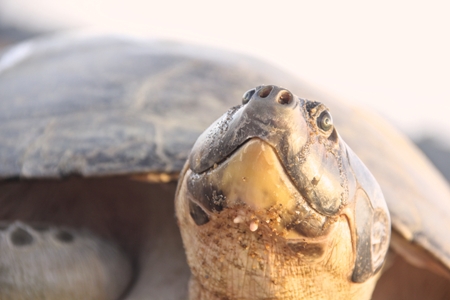Turtles are reptiles that are easy to recognize by their two-part shell: the carapace and plastron, and by a rigid corneal beak to help feeding. They do not have teeth, unlike most vertebrates.
WCS-Brazil decided to focus on conservation of Amazonian river turtles, especially the five species of the Podocnemididae family (described below), because they are threatened species due to high demand for their eggs and meat. Turtles are a traditional source of protein for forest communities, but if unbridled consumption and environmental change resulting from human activities were to continue, the future of this group would be uncertain.
WCS focal species in the Podocnemididae family:
Giant South American River Turtle (Podocnemis expansa): this is considered the largest species of the genus Podocnemis, reaching up to 90 cm in length and a weight of 65 kg. They are omnivores,but prefer leaves, fruit and stems. They lay 100 – 150 eggs per year in high beaches of coarse sand.

Yellow-spotted River Turtle (Podocnemis unifilis): this is considered the most common species of the genus. They reach 50 cm in length and a weight of 12 kg, and the juveniles and adult males have yellow markings on their heads. They are omnivores, but prefer fruit, seeds and stems. They lay on average 30 egg sin different places, such as beaches, clay banks and among fallen leaves.
Six-tubercled Amazon River Turtle (Podocnemis sextuberculata): this is one of the smallest species in the Podocnemis genus, reaching 34 cm in length and a weight of 3.5 kg. The young can be distinguished from other species by the presence of six tubercles on the plastron, which disappear in adults. They are mainly herbivorous, eating grasses. They lay an average of 16 eggs on beaches.
Red-headed Amazon River Turtle (Podocnemiserythrocephala): this is considered to be the smallest of the genus Podocnemis, reaching 34 cm in length and a weight of 2.8 kg. The young and adults have red markings on their heads. Their preferred food is fruit and seeds. They lay around eight eggs in sandy areas(campina) and beaches of clear water and, especially, black water.
Big-headed Amazon River Turtle(Peltocephalus dumeriliana): unlike other members of the Podocnemididae family,the males are larger than the females, reaching 50 cm in length and a weight of 11 kg. They have a large head and mouths shaped like parrot beaks. They live in deep areas of rivers and creeks. They lay on average 16 large eggs in nests in the banks of forest creeks.
Conservation Status:
Globally there are around 330 turtle species, of which between 48 and 54% of species are threatened by some sort of human activity. This means that the group is among the most threatened of vertebrates. In the Brazilian Amazon the level of threat is similar to the rest of the world, in that only five of the sixteen species are not considered threatened, probably because of a lack of information on them (Rinoclemys punctularia, Phrynopsraniceps, P. gibbus, Platemys platycephala and Rhinemys rufipes).
Among the threatened species in the Brazilian Amazon, the Podocnemididae family stands out, due to the unbridled consumption of eggs and meat ever since Portuguese colonization of the nineteenth century,especially along the Amazon River, Madeira River and Rio Negro. Just in the region of the town of Tefé,around 58 million Giant South American River Turtle eggs were harvested every year for consumption and oil to light the town (Bates, 1979; Klemens &Thorbjarnarson, 1995).
Ecological importance:
River turtles inhabit both aquatic and terrestrial areas. Where they occur they are responsible for various ecological processes such as seed dispersal. Their varied diet includes plants (leaves,fruits and seeds), insects, fish and dead matter, and they are part of complex food webs, both as predators and prey, as they are eaten by caiman, large fish,mammals, birds and other animals. Thus the group is important for nutrient cycling (transforming live and dead organic matter into animal protein) in the forest and aquatic environments. By consuming large amounts of dead material they act as ‘cleaners’ of the rivers.